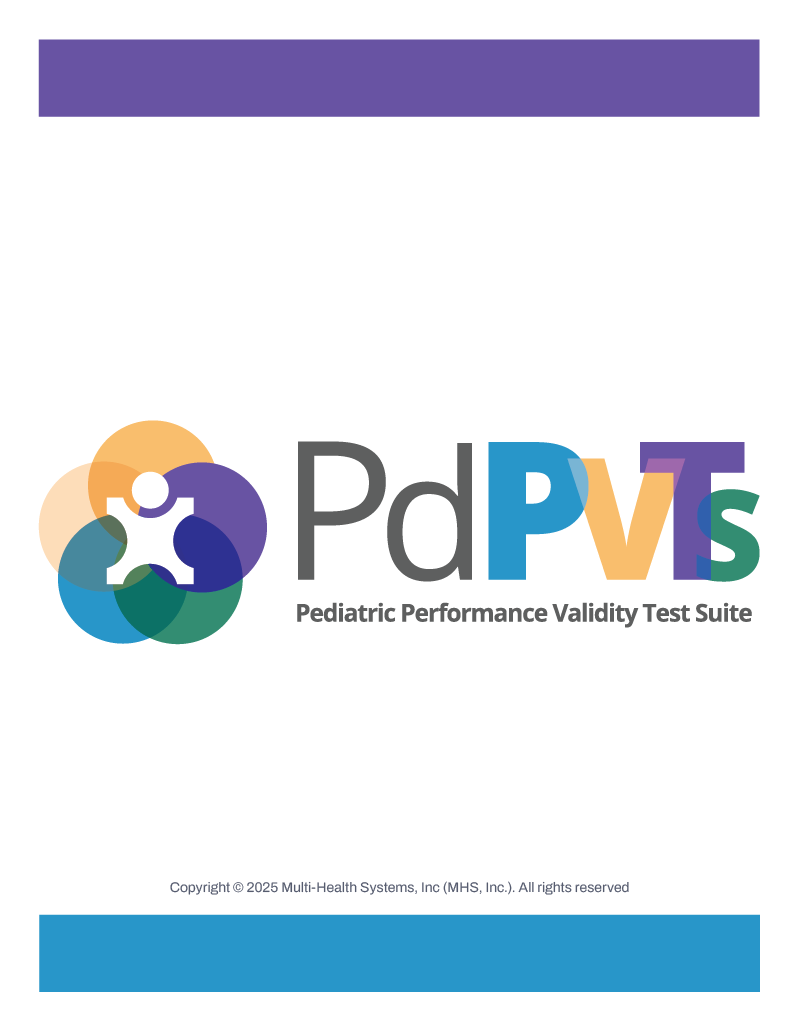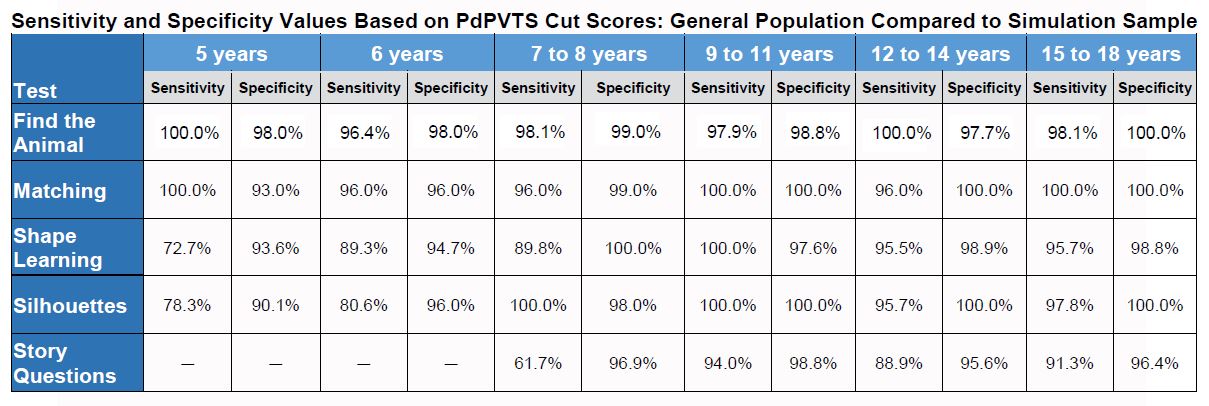
Paediatric Performance Validity Test Suite [PdPVTS]
Assesses performance validity in youth in just 3-5 minutes with five stand-alone tests
For Ages: 5 – 18 years for the four visual tests; 7 – 18 years for the verbal test
Administration Time: 3 – 5 minutes per test; 5 individual tests
Administration Type: Individually-completed; Clinician administered
Format: Downloadable application for iOS or Windows; Online or offline administration and scoring
System Requirements: Tablet, desktop, or laptop; iOS 10, 11, 12, or 13; Windows®10
Authors: Robert J. McCaffrey, PhD, Julie K. Lynch, PhD, Robert A. Leark, PhD, and Cecil R. Reynolds, PhD
Online Forms, Reports, Kits & e-Manuals
All online resources including Forms, Reports, i-Admins, Kits and e-Manuals.
PdPVTS 1 Year Unlimited License
When to use
How do you determine if a child’s performance on cognitive tests is reflective of maximum performance? The PdPVTS helps to answer this question with five digital and engaging performance validity tests (PVTs) simple enough to be completed successfully by even the most severely cognitively impaired individuals. The PdPVTS is the first ever digital suite of performance validity tests for youth that will add little time or effort to an evaluation for the significant benefit of knowing if interpretation of test scores is likely to be valid. It also allows for flexible administration as the five stand-alone tests can be individually-administered or used in combination.
How it works
The tests were designed to be inserted at various points throughout a full test battery to assess for maximum performance across time. Each test includes instructions to be read aloud by the examiner, a demo video, and practice items. The youth responds directly on the device, with the exception of the verbal test, where the youth responds aloud to examiner-read items. In less than 5 minutes, you can determine if a child’s score is reflective of maximum performance. To access the Remote Administration Guidelines, click here.
Key Features and Benefits
- Flexible administration; 5 stand-alone tests that may be used individually or in combination
- Quick to complete; each test takes only 3–5 minutes to administer
- Measures performance validity throughout an evaluation
- Digital format makes it easy to use, portable, and engaging
- Large validation samples including: general population (N = 838), simulation (N = 300) and clinical (N = 487) samples
- Age-specific cut scores
- No limitations based on reading ability, as reading is not required by the youth
- Works online and offline
- Culturally neutral items
- Fair across a wide range of demographics (i.e., age, gender, race/ethnicity, and parental education level)
- Appropriate for children with visual, hearing, or motor impairments
- Designed for youth with youth
Resources & Sample Reports
The Paediatric Performance Validity Test SuiteTM (PdPVTSTM) is a suite of five stand-alone paediatric performance validity tests designed to assess maximum performance across time in both visual and verbal domains. The PdPVTS is delivered in a fully digital format for use on iOS and Windows touchscreen devices.
Who is it for?
Clinicians with B-level qualifications who administer paediatric neuropsychological/psychoeducational evaluations, whether the evaluation is completed for clinical, educational or forensic purposes. Although the PdPVTS is easy enough for many individuals to administer, a psychologist who recognizes the limitations of such diagnostic procedures must assume the ultimate responsibility for its administration, scoring, and interpretation.
What makes it unique?
The PdPVTS is the first ever digital suite of performance validity tests for youth that will add little time or effort to an evaluation for the significant benefit of knowing if interpretation of test scores is likely to be valid. It also allows for flexible administration as the five stand-alone tests can be individually-administered or used in combination.
Five Stand-Alone Tests
The PdPVTS consists of five stand-alone paediatric performance validity tests across both visual and verbal domains, including: Visual Scanning and Classification, Visual Recognition, Visual Organization, and Verbal Recognition. Each test can be used individually or together and only consumes one use.
1. Visual Scanning and Classification
Find the Animal: Qualities of a nonverbal classification test and picture scanning test. Examinee identifies the animal from a selection of seven pictures then returns their finger to a home button.
Number of Items: 25
2. Visual Recognition
Matching: Examinee selects from a display of three pictures the picture shown on the previous screen.
Number of items: 25
3. Visual Recognition
Shape Learning: Examinee identifies from two pictures the picture that was presented on the previous screen.
Number of items: 25
4. Visual Organization
Silhouettes: Similar to a Gestalt completion test, examinee determines of three solid pictures, which is the completed version of a picture with missing pieces.
Number of items: 25
5. Verbal Recognition
Story Questions: Examinee responds to multiple choice questions about a story read to them by the examiner.
Number of items:
7 – 11 Years: 9 two-sentence stories, 2 questions each (18 total)
12 – 18 Years: 4 short stories, 5 questions each (20 total)
Scoring
In-Application Results
As soon as a test is completed, results in the form of an obtained score and outcome (i.e., pass/fail) are accessible in the application. You can “share” a PDF of the results that can be saved or emailed at your convenience.
Generate a Score Report through your MHS Online Assessment Center +
Access the Score Report online through the MHS Online Assessment Center Plus (MAC+). Age-specific cut scores are compared to the child’s obtained score on each test to determine if the child failed one or more of the PVTs. Base rates for failing a specific test or combination of tests in the general population and clinical samples (including 10 clinical groups), are also provided in the Score Report.

Validation Data
The PdPVTS was validated in a general population sample (N = 838) that was demographically representative of the
U.S. population with respect to race/ethnicity, parental education level, and U.S. Census region.
Further validation was completed in 281 youth in a series of simulation studies.
Data were also collected from a large clinical sample of youth diagnosed with ADHD (N = 147), anxiety-related
disorders (N = 65), behavior disorders (N = 65; including Oppositional Defiant Disorder and Conduct Disorder),
depression (N = 58), Intellectual Disability (N = 81), Language Disorder (N = 63), Specific Learning Disability (N = 78),
mild traumatic brain injuries (N = 50), and moderate/severe traumatic brain injuries (N = 23).

 NZ
NZ




